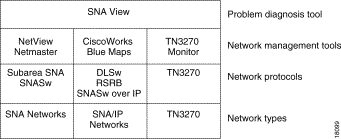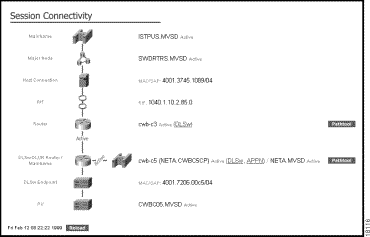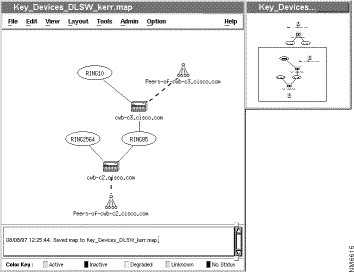|
|

 |
Note The information in this chapter applies to both UNIX workstations (Maps and SNA View) and Windows NT systems (SNA View). |
This chapter introduces the functions and capabilities of CiscoWorks Blue Maps and SNA View. CiscoWorks Blue Maps and CiscoWorks Blue SNA View provide a set of Motif1 and Web-based applications for diagnosing problems in, and managing, integrated networks based on Systems Network Architecture (SNA) and Transmission Control Protocol/Internet Protocol (TCP/IP) environments.
This chapter includes the following main sections:
The world of SNA networking is divided into the following three fundamental environments:
Figure 1-1 shows the types of SNA networks.

In these SNA networks, the mix of protocols run by the mainframe computer, the network, and the end-user devices varies, as shown in Figure 1-2.

These various SNA networks run a variety of protocols to transport data between the mainframe computer and the network nodes over the network. The SNA network protocols are shown in Figure 1-3.

Network management programs, which are tools that you use to manage these SNA networks, also vary depending on the protocols used, as shown in Figure 1-4.

There is one tool that lets you identify and isolate outages in all SNA networks. SNA View, as shown in Figure 1-5, lets you see network connectivity views for the three types of SNA networks.

When managing SNA networks, diagnosing problems, the distinctions between diagnosis and management must be clear:
Cisco offers a set of SNA network management and problem diagnosis tools to help you perform these tasks.
 |
Note Cisco's TN3270 Monitor products are available on UNIX workstations only. |
 |
Note CiscoWorks Blue Maps is available on UNIX workstations only. |
There is a trend in network management to reduce the need for separate network resource managers by providing direct management of heterogeneous multi-vendor networks from a single, integrated network management system (NMS). In keeping with this strategy, CiscoWorks Blue uses information from Virtual Telecommunications Access Method (VTAM) and the Multiple Virtual Storage system (MVS) to enable network administrators to monitor and manage SNA resources. To further simplify and enhance network management, use CiscoWorks Blue Maps to display your SNA resources on graphical network maps.
The CiscoWorks Blue workstation program runs on a UNIX workstation or Windows NT system to collect SNA network information provided by the Maps and SNA View mainframe program. It provides the SNA control and correlation needed to manage SNA devices from a UNIX workstation, allowing the network administrator to see beyond the routers to the SNA physical unit (PU) and LU resources.
CiscoWorks Blue gets PU and LU resource information from VTAM at a mainframe computer and correlates that information with the Cisco routers that are associated with the PUs and LUs. By interacting with the mainframe, CiscoWorks Blue adds vital PU and LU information to the graphical maps. Because CiscoWorks Blue correlates PU and LU names with the routers in the network, you can more easily isolate problems to the IP network or to the SNA network.
Resource information is dynamically updated to provide a snapshot of the network as it appears at any given time. This information allows the administrator to display a graphical map that depicts details from the PU back toward the VTAM host, providing information, such as the PU and LU status and the PU and LU dependency relationships.
This section presents a brief overview of the functions provided by CiscoWorks Blue SNA View. SNA View is a web-based application. The SNA View web server runs in a UNIX workstation or Windows NT system gathering information about routers and SNA LUs and PUs from the SNA View and Maps database. When you link to the SNA View web page, you can display SNA session paths. The web page then displays a session connectivity view, as shown in Figure 1-6.

The CiscoWorks Blue SNA View product is a tool for problem diagnosis in all SNA networks.
CiscoWorks Blue SNA View offers web-based client and server applications. These applications start with as much information about a failing node as you can provide and then display the network devices between that node and the mainframe computer.
On UNIX workstations, CiscoWorks Blue Maps is a set of applications that let you manage Cisco routers in an IBM SNA network. Each Maps application focuses on a particular protocol: DLSw, RSRB, or APPN. Maps displays graphical views of SNA networks connected with Cisco routers. These views are dynamically updated to provide snapshots of the network as it appears at any time.
Maps also lets you see beyond the routers to the SNA PUs and LUs that use the DLSw, RSRB, or APPN protocols. The Maps mainframe component discovers the PUs and LUs from VTAM information at the mainframe, monitors those PUs and LUs, and reports their changing status to the Maps workstation applications to update the Maps database and the graphical maps.
The CiscoWorks Blue Maps product provides the following Motif and web-based applications that show, in a graphical or tabular format, the routers that make up your integrated SNA and TCP/IP network:
CiscoWorks Blue Maps applications provide the following features:
CiscoWorks Blue Maps applications get network data from the MIBs to provide detailed logical maps of the SNA-related protocols. These maps are automatically drawn to depict specific protocols in the network. For example, the DLSw key devices map provides a view of the key DLSw routers with their peer routers and the rings and peer connections between them. Topology is drawn based on the DLSw protocol, and you can focus on different components of the DLSw network such as individual routers and links. Figure 1-7 is a sample DLSw key devices view. It shows you a small set of routers that you designate as "key devices" based on their networking attributes. This map also shows you the peer routers to those key routers, and it shows you the peer connections that connect the key routers to their peers.

CiscoWorks Blue Maps provides the network administrator with the tools needed to manage growing integrated SNA and TCP/IP networks. This set of Maps applications (RSRB, DLSw, and APPN) can be integrated with popular Simple Network Management Protocol (SNMP) management platforms such as IBM NetView for AIX, HP OpenView, or SunNet Manager. From the graphical maps, you can display path information or go directly to a device view using CiscoView.
You can use the graphical maps to efficiently identify and diagnose problems related to the specific protocol under observation (RSRB, DLSw, and APPN). Having identified the problem area, you can easily access additional information by invoking other menus in the application. For instance, in a DLSw network, you can use a key routers view to display a selected set of routers and their peer connections. From this view, you can then display information about peer routers, peer connections, and DLSw circuits. You can also view new nodes as they are added, and view the changing status of the devices and links dynamically.
CiscoWorks Blue Maps offers both Motif-based and web-based network management applications for those using UNIX workstations.
CiscoWorks Blue Maps offers a set of network management applications that use the X Window System and Motif graphical interfaces to display graphical maps of the nodes and links in your network. Each application focuses on a particular protocol: DLSw, RSRB, or APPN.
CiscoWorks Blue Maps offers a set of web-based client/server applications that let you use web browsers to display information about RSRB, DLSw, and APPN networks. The network information is presented in a tabular format. The web server runs on your Maps workstation and collects information from the Cisco routers in the network. You can use a web browser from any workstation in the network to connect to the web server to view the network.
When you install the CiscoWorks Blue products, you always install all the code, whether you license maps, SNA View, or both. Maps and SNA View use many common functions:
 |
Note CiscoWorks Blue SNA View is supported on Windows NT; however, CiscoWorks Blue Maps is not supported on Windows NT. CiscoWorks Blue Maps and SNA View 3.0 are both supported on the AIX, HP, and Solaris UNIX platforms. |
The following major changes have been made in CiscoWorks Blue Maps and SNA View Release 3.0:
![]()
![]()
![]()
![]()
![]()
![]()
![]()
![]()
Posted: Mon Sep 4 10:51:02 PDT 2000
Copyright 1989-2000©Cisco Systems Inc.